Table of Contents Show
An unlikely candidate for “summer indie blockbuster” hit theaters after a year of delays ((Ruimy, John. “A24’s ‘The Green Knight’ Officially Abandons May 29 Release, Delayed To Undetermined Date.” worldofreel. May 9, 2020.)) on July 30: The Green Knight (2021), adapted from an anonymously-written King Arthur spin-off poem from the fourteenth century entitled Sir Gawain and the Green Knight. The original poem has all the hallmarks of a Hollywood hit, from its adventure and honor-seeking protagonist Sir Gawain (pronounced Gah-win) to the forbidden love story between Gawain and his host’s wife, to the mysterious antagonist the Green Knight. David Lowery’s film transforms the chivalric romance into a thriller, using the text’s fixations on myth, magic, and transgressions of honor and duty to create a medieval thriller that heightens the fear and sexuality Gawain experiences in the poem.
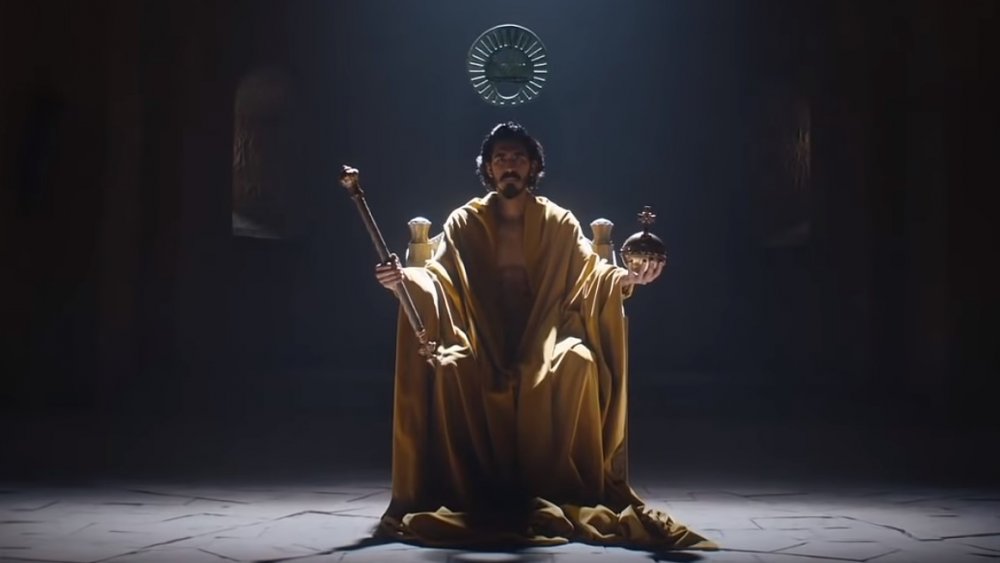
However, the film is a stark detraction from much of the original poem such a beautiful, timeless tale. Though Dev Patel shines as Sir Gawain, the film’s overemphasis on sexuality detracts from the tale of courtly love and the chivalric Gawain from the poem. Nonetheless, the themes of shame, retribution, and cycles of death and honor present in The Green Knight create their own story because of the way Lowery uses hallmarks of the thriller genre in his retelling of the poem.
The Green Knight (2021)
The Green Knight has an understated yet remarkably talented cast. It stars Dev Patel as Sir Gawain, Alicia Vikander as Essel / The Lady, and Joel Edgerton as the Lord. Sean Harris as King Arthur, Kate Dickie as Queen Guinevere, Ralph Ineson as the Green Knight, and Sarita Choudhury as Gawain’s Mother round out the supporting cast. Lowery directs, writes, and produces an indie film sweetheart A24 distributes.
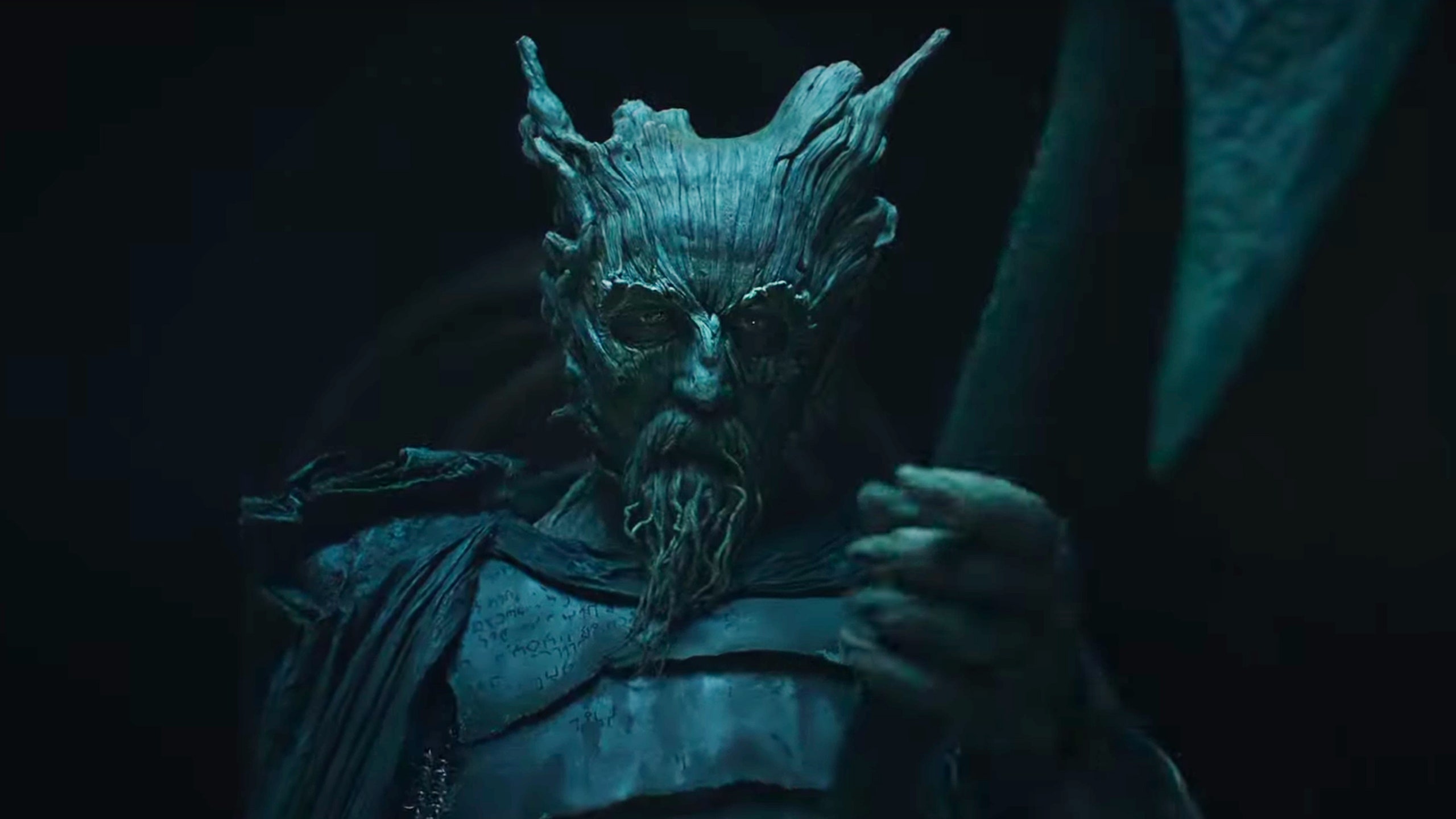
On Christmas Day, Gawain awakes in the brothel he has been staying in with his lover Essel before returning home to the palace of Camelot to prepare for the Christmas Feast. He meets with his mother, who is alluded to be Morgan le Fay the witch, who tells him that she will not be attending the feast — it is soon revealed that she will not be attending in order to create a magical being, the Green Knight so that Gawain can test his honor and go on a quest. In front of King Arthur and the court at Camelot, the Green Knight appears and challenges the knights present to a game: whoever accepts the challenge and can win a blow against him may keep his ax, so long as he vows to receive the same blow in return in a year.
Gawain accepts and, confused as to why the Green Knight willingly bares his neck as opposed to fighting him, slices his head off. The Green Knight picks up his head and tells Gawain to meet him at the Green Chapel the following Christmas to hold up his end of the game. When the next Christmas comes around, Gawain sets out on his very first quest, determined to uphold his end of the game. After a series of short misadventures, he finds himself in the castle of a mysterious Lord and Lady. The Lord compels Gawain to enter into a game with the rules that whatever he catches on his hunt will be given to Gawain in exchange for whatever Gawain receives at the castle that day. The Lady (who looks like Essel) seduces Gawain, and they have a sexual encounter that Gawain knows he cannot repay to the Lord.
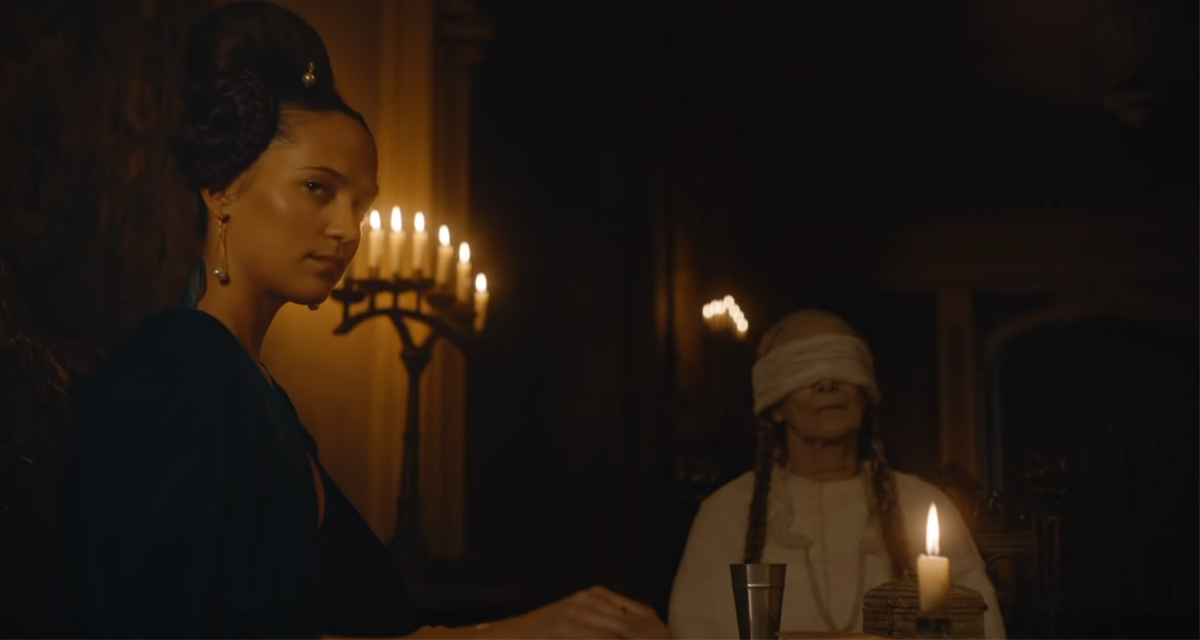
Gawain eventually meets the Green Knight in the Green Chapel but finds that his fear is far too great to follow through with the end of the game. In what is revealed to be a vision of what would happen had he not let the Green Knight chop off his head, a montage shows Gawain’s long and unfulfilling life as king of Camelot. Gawain snaps out of his vision, tells the Green Knight he is ready to face his fate and casts off the magical sash. The Green Knight reveals himself to be the Lord from the castle and praises him for winning the game. The final shot is the Green Knight saying “off with your head” to Gawain. (( Lowery, David, dir. The Green Knight. 2021. ))
Key Differences From The Original
The Green Knight takes significant liberties with the plot of the original epic poem. Where the poem merely alludes to the physical quest — and quest being the journey Gawain takes from Camelot to the castle of the mysterious Lord and Lady, called Bertilak in the poem — the film takes its time showing his adventures on screen instead of leaving it to a montage or to the audience’s imagination. The poem is more concerned with how Gawain interacts with the Lord and Lady at their castle than with the actual quest itself, which is why parts of The Green Knight feel out of place to readers of the epic poem.
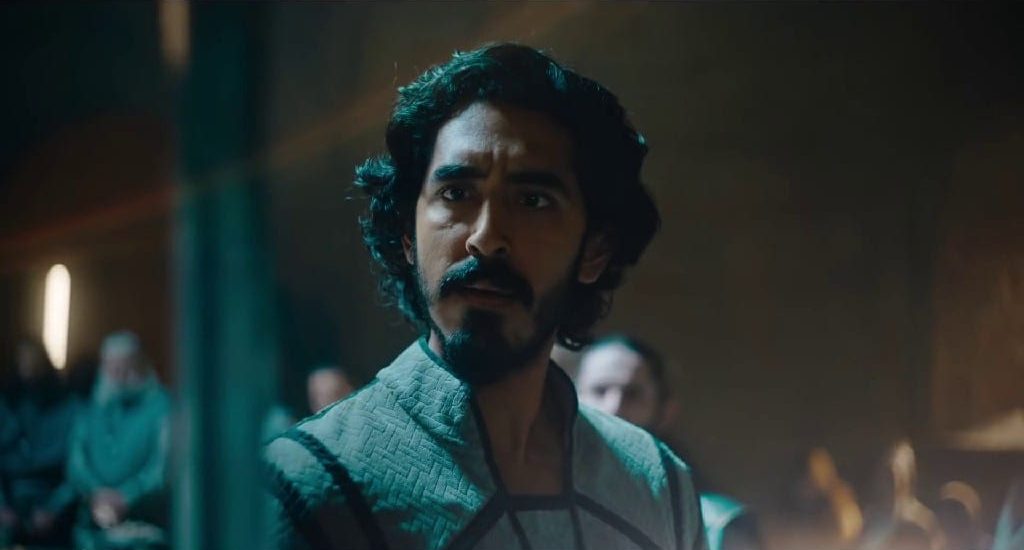
The epic poem begins not at Christmas but on New Year’s Eve. The feast plays out similarly to the film, with the Green Knight arriving and proposing his game to the knights of Camelot. When the next New Year comes, Gawain sets off on his quest; the adventures on his quest are merely alluded to, not shown or described to the detail they are in the film. He arrives at the court and castle of Lord Bertilak and his beautiful wife, where he decides to rest up for his battle with the Green Knight. Lord Bertilak proposes the same game to Gawain as in the film, but instead of the events at his castle playing out over just one day, it happens over three. Gawain and Lady Bertilak flirt and exchange kisses during the day while Gawain and Lord Bertilak talk at night. Lady Bertilak gives Gawain the magical sash to protect him in his fight with the Green Knight — which is revealed to be the reason for why his neck is nicked when the Green Knight returns his blow. Finally, it is revealed that the Green Knight is actually Lord Bertilak, under an enchantment by Morgan le Fay and Gawain returns home to Camelot, feeling a sense of shame, and vows to wear the sash as a token of this shame.
Lowery underplays the importance of Gawain’s time at the palace of Lord and Lady Bertilak, which is where the film suffers. The additional quest scenes are interesting for sure, and the Saint Winifred scene is arguably one of the best in the entire film since it shows Gawain’s more gentle, chivalric side. Still, their inclusion detracts from what is really Gawain’s most important lesson in honor: the game he plays with Lord Bertilak at his castle. Reducing the time Gawain spends at their castle from several days to just one day takes away its importance entirely, treating it as just one side adventure rather than the focal point of his development like the poem. Repetition is essential to Sir Gawain and the Green Knight because of how it builds tension and narrative drama — something that Lowery could have used to his advantage in making his medieval thriller.
The Lord And Lady’s Castle
Going into this film, the expectation was there were going to be grand scenes of Lord Bertilak and all his men hunting in the forest since the Gawain poet actually takes much of his time describing all three days of the hunt, but there was none of this to be found. Especially with all of the beautiful location shots in The Green Knight, having the hunting scenes — which are supposed to be masculine scenes that contrast the feminine scenes of Gawain interacting with all the ladies at the castle — would have been a wonderful feature of the film and an excellent way for Lowery to show off his attention to detail in the frame.
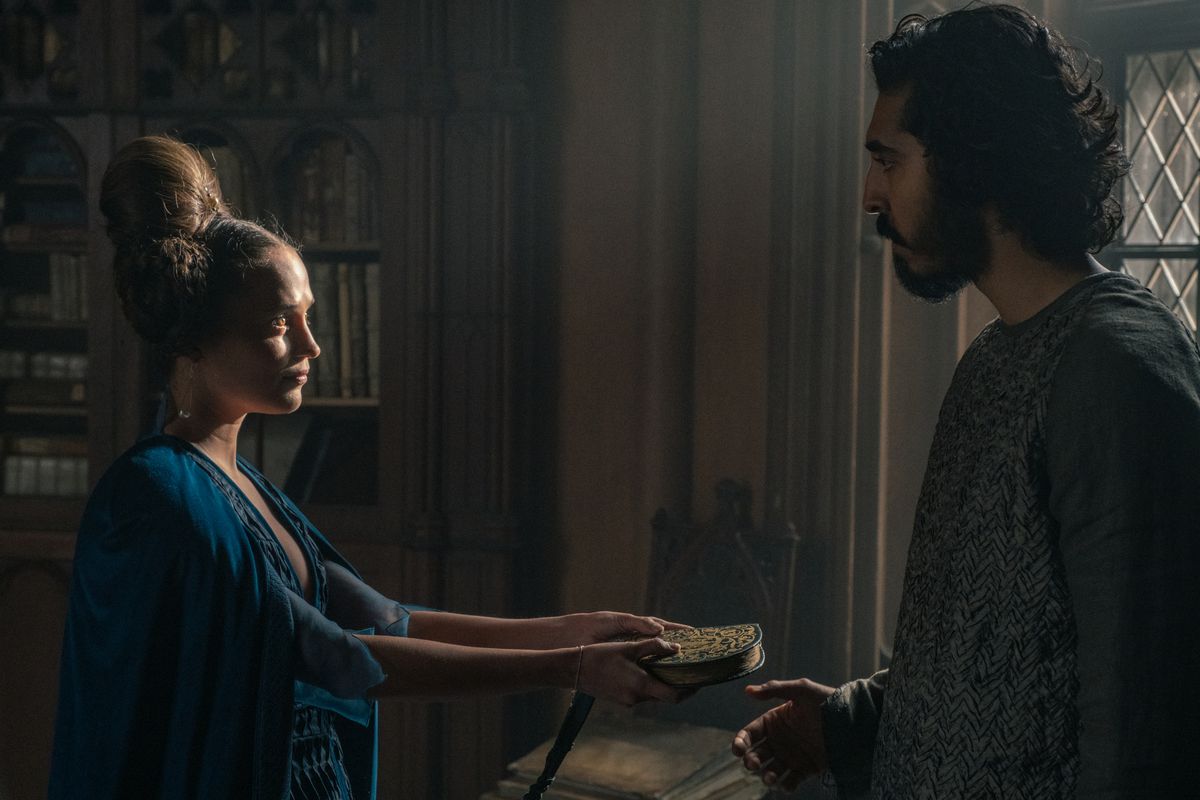
The overemphasis on sexuality becomes more visible through the downplaying of Gawain’s time at Lord Bertilak’s castle. By reducing the days, Gawain spends with the mysterious Lord and Lady, the build-up to the third day where Gawain and the Lady (scandalously) kiss three times is lost. Lowery compresses the flirtations and subsequent building in the number of kisses into a single, hyper-sexual interaction that is not found anywhere in the poem. Another detail here is that in the poem, the Lady gives Gawain her magical sash; it is not a gift of Gawain’s mother. The highly sexual affair Gawain and the Lady have worked for the film but does not work for the film as an adaptation of the poem. When looking at this act of the film, it becomes clear that Lowery is attempting to do something different than the Gawain poet.
The Green Knight manufactures a romance between the sex worker Essel and Gawain that is nonexistent in the poem, perhaps as a way of making it more “sexy” due to their number of love scenes throughout the first part of the film and in the vision scene. This addition, while innocuous, doesn’t really lead anywhere, and Gawain isn’t shown making grand, chivalric gestures for her as a knight should; she is not part of his journey to becoming a knight and an honorable man; rather, Essel is treated simply as a sex object with little narrative function. Since Vikander plays both Essel and the Lady in the film, perhaps Lowery is attempting to say that Gawain gave into the Lady’s sexual advances because she looks like Essel. But having this little detail doesn’t really add to the film because Gawain never intended to have any sexual relationship with the Lady in the poem.
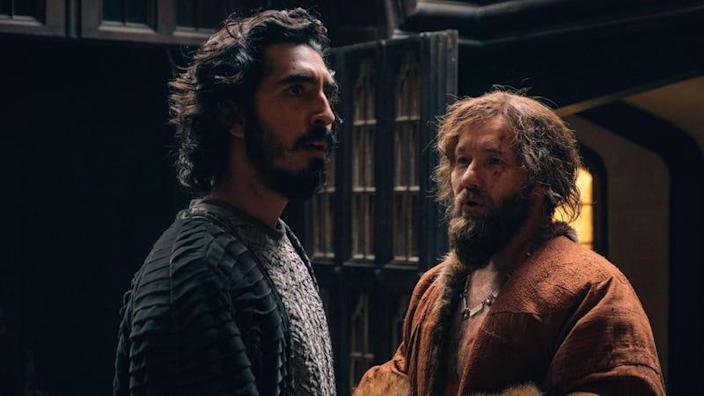
The most essential aspect of the poem is that the Green Knight is actually Lord Bertilak in magical disguise, enchanted by Morgan le Fay. While this is explored in the film slightly, the audience never gets the explicit reveal that the Lord is actually the Green Knight. Gawain’s final showdown with the Green Knight feels rather anticlimactic in that regard, then, because if the film was following the poem more closely, Gawain would have worn the magical sash when his head was getting chopped off, which would have caused a nick on the back of his neck to remind him of his shame.
This final test, where Gawain reveals that he had concealed the sash to Lord Bertilak / the Green Knight, is not replicated in the film; rather, Gawain casts off the sash and willingly accepts his fate. This is a complete betrayal of what the morality tale is trying to communicate about human weakness and fallacy. At the end of the poem, Gawain is supposed to live with the shame that he behaved deceitfully in his game with the Green Knight and return to Camelot as a man who has acted without honor, wearing the sash as a reminder of his weakness, even though the Green Knight calls him “blameless.” The film does not follow this ending, but the film had different goals with this adaptation, trying to capture more of the poem’s broad strokes rather than be an exact retelling. However, it still does hurt to know that Lowery compromised the true message of the poem for a shock ending that does not actually reflect the poem’s function as a morality tale.
Mythical Elements
The plot of the film is driven by the myth of King Arthur and the magical efforts of Gawain’s mother. The original poem also utilizes the popular King Arthur stories in its story of Gawain, who is typically seen as a lesser knight and an unlikely hero. The poem and film both require that Gawain try to make his name and honor in a mythical world full of legendary figures. The magical elements, too, add drama to the story and contribute to the notion that the stakes are not just material — they are supernatural, spiritual, even. They push Gawain to the extreme and force him to test his honor in ways he would not otherwise.
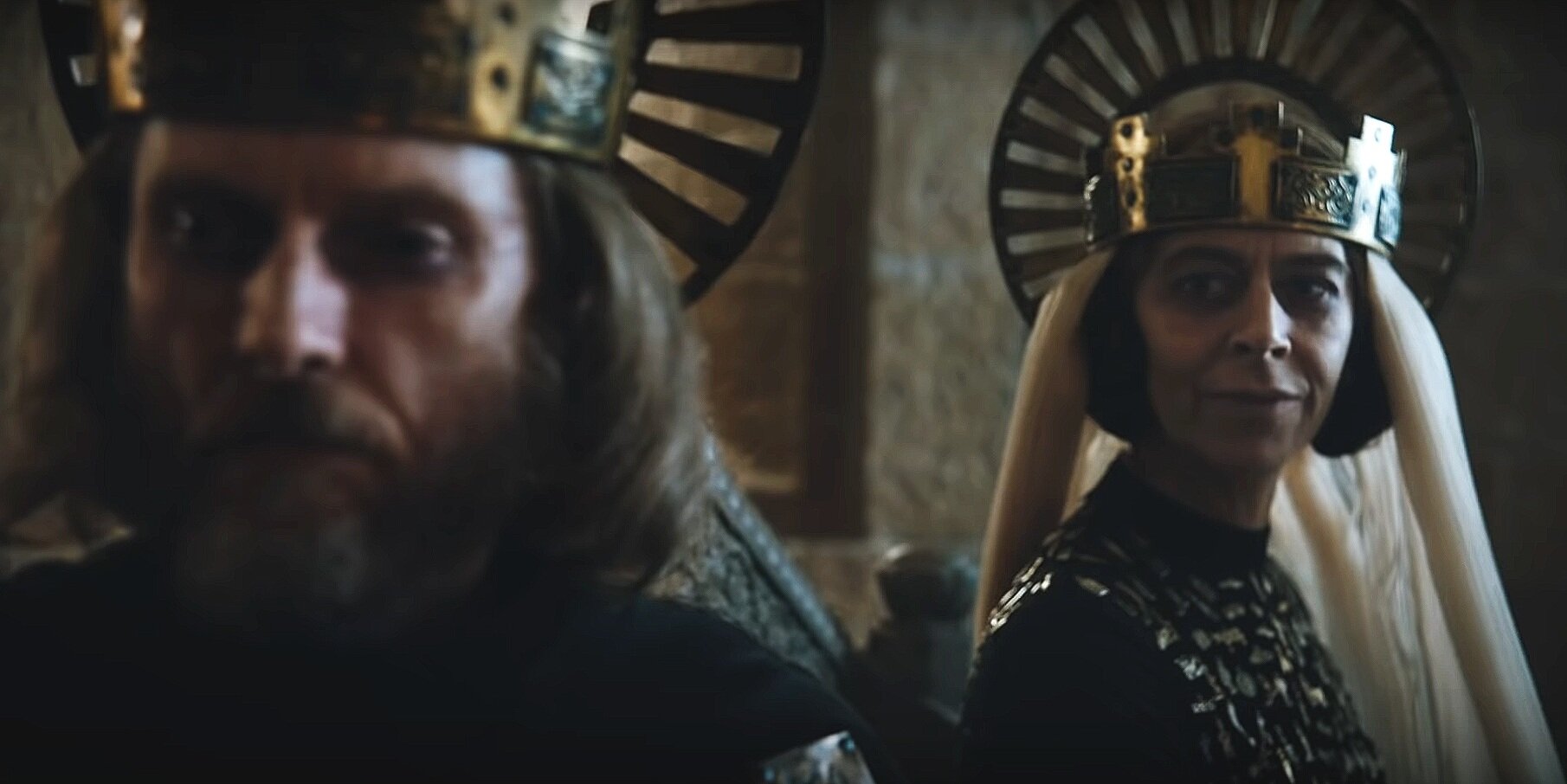
By focusing on myth and magic in Gawain’s story, Lowery creates an aura of mystery surrounding the events of his film that keep the viewer on the edge of their seat. King Arthur and Queen Guinevere wear crowns that have haloes mounted to them, deifying them and making them resemble the larger-than-life figures from British mythology they are. Even though they are both long past their prime and dressed rather plainly, the crowns they wear are a solid reminder of their identities at Camelot and their ties to the Christian-inflected stories of the quest for the Holy Grail.
The very foundation of The Green Knight needs this agéd Arthur, who is too old to go on quests, for Gawain to take his place among and carry on the myth of King Arthur and the Knights of the Round Table. The Green Knight and Queen Guinevere encourage Gawain to do these great deeds to prove why he should be a knight. Lowery’s script emphasizes that Gawain must become a knight through his trials; the Lady says after their sexual liaison that Gawain is “no knight” yet, alluding to the fact that he has not shown chivalric honor in her presence and hasn’t undergone some trial that would make him a mythical Knight of the Round Table.
Magical Intervention
The elements of magic are emphasized even further in Lowery’s film than in the poem because of how his extratextual scenes, including Morgan le Fay and her witches conjuring the Green Knight and the encounter between Gawain and Winifred. By showing the act of Morgan le Fay and the witches creating the Green Knight instead of revealing it at the end of the film (like the poem does), the audience is primed from the beginning to see the story as one of magic and supernatural intervention. When Queen Guinevere reads aloud the Green Knight’s letter of declaration, the air goes dark, and her face lights up green, her eyes glaze over as if she is in a trance — she is being manipulated by the powers of the witches. The dark magic, done clandestinely in a tower, shows that external, powerful forces manipulate the story of our hero Gawain.
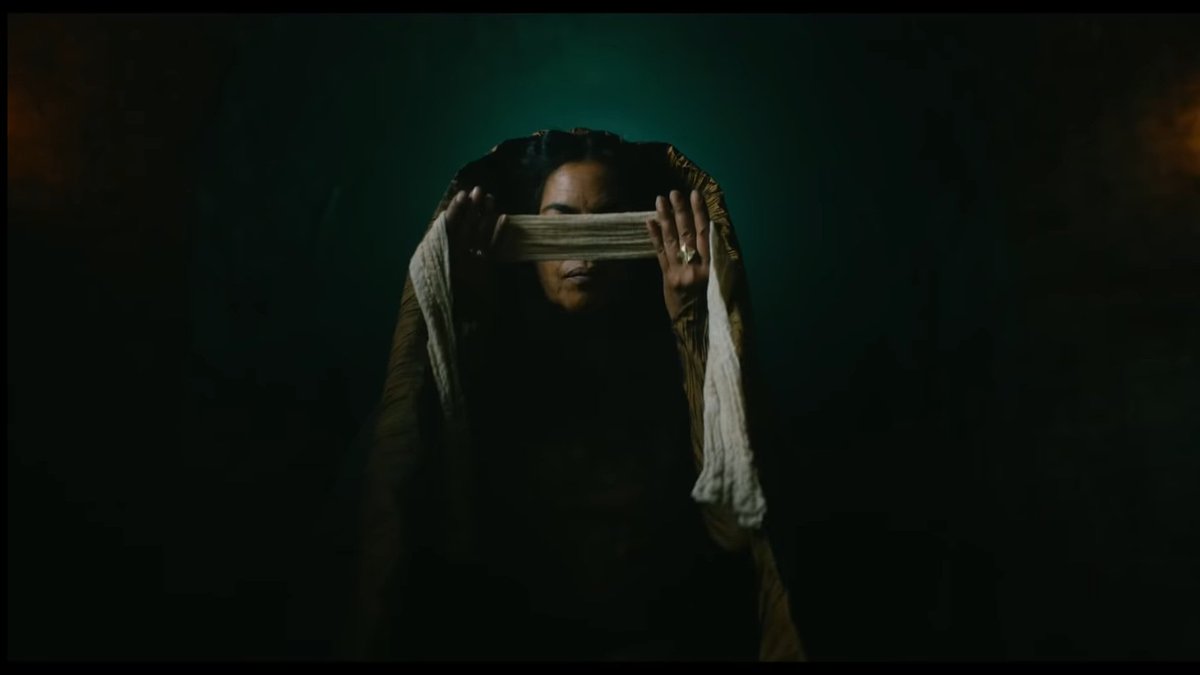
The magical elements from the poem, like the sash of impenetrability, are treated like a Macguffin and shot with extreme care; in the vision scene where Gawain escapes the Green Knight, the camera always pans down to Gawain’s waist to show the sash he never removes. Lowery reminds the audience that magic can be the force for development in a character or lack thereof and that they are an essential part of this world Gawain must navigate on his quest.
Myth and magic meet in the best scene from the film: the encounter between Winifred and Gawain in her cabin. The title card ahead of this scene says that Winifred is actually “Saint Winifred,” a popular saint in medieval England hagiography (the writings of the lives of saints) who was decapitated when her suitor was furious to discover her intent to become a nun. The film’s Winifred had a traveling man assault her and then decapitate her for refusing his advances, but the reference to the saint is still present. She appears to Gawain as a ghost, levitating approaching him and questioning why he is in her home.
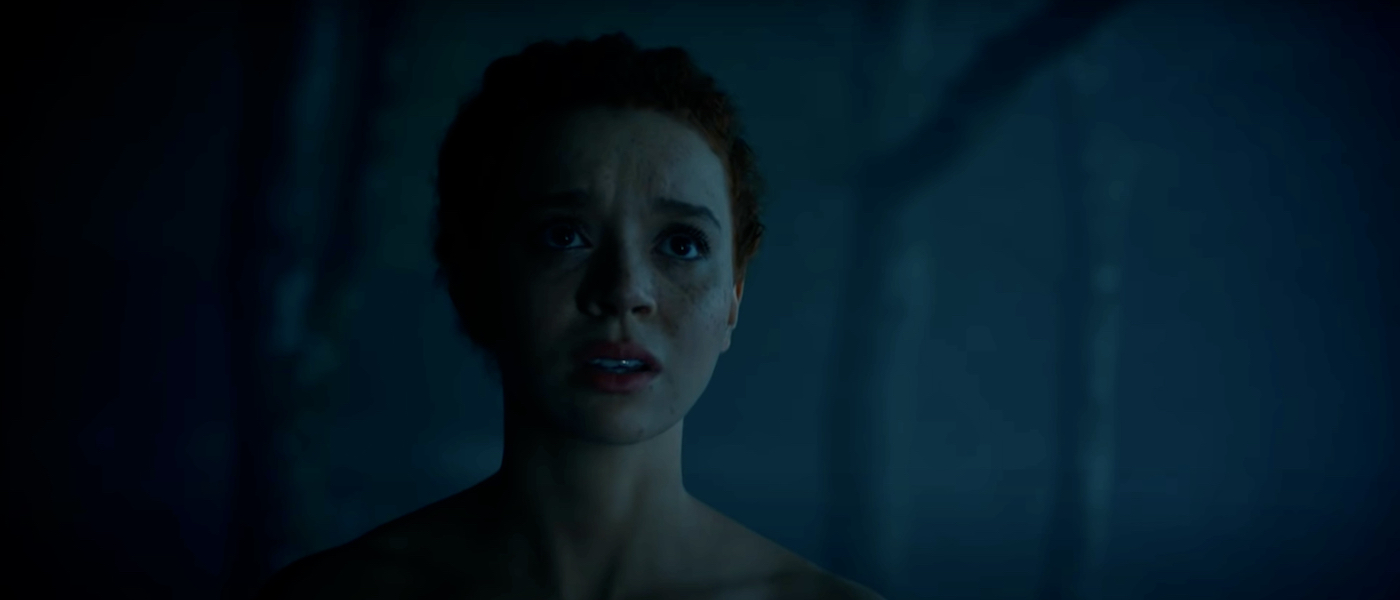
When Gawain returns to the cabin with her severed head to return it, it transforms from a skull to the actual form of her face and speaks to him, a sign of her magical and supernatural presence. The ax also magically appears as a result of Gawain’s fulfillment of her request, another example of her powers. The visual darkness but emotional sincerity of the scene, with the physical frailty and supernatural powers of Winifred, create a compelling scene that tests Gawain’s chivalry.
The artful use of the King Arthur myth and Morgan le Fay’s magic in The Green Knight add to the aura of mystery and give him the space to make the unassuming chivalric romance a thriller. The myth and magic woven into the script heighten the narrative tension and force Gawain to confront the forces working against him and become a hero. Lowery shows audiences a man worthy of becoming a knight by placing a normal man with no powers of any sort, just his own will, and determination, against mythical and magical threats.
Playing With The Thriller Genre
Lowery heightens the tension associated with thriller films through his lingering on the actual journey part of the quest, constantly putting Gawain up against life or death situations that threaten his progress. The journey north, and the events that pass on it, are merely alluded to by the Gawain poet (a name assigned to the anonymous writer of the poem) but are highly emphasized by Lowery in order to build suspense for the final showdown between Gawain and the Green Knight.
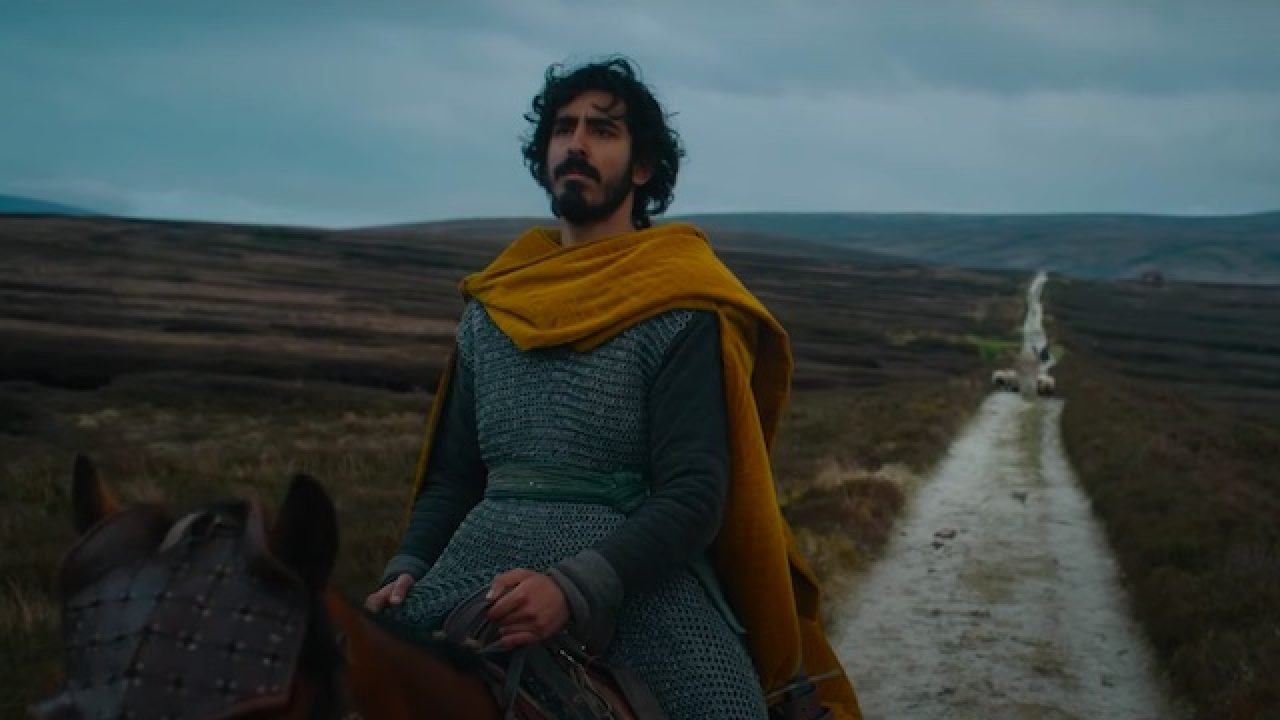
The Green Knight also has countless scenes of Gawain riding through the moors and through the forest, suggesting that nature is also a foreboding and destructive force. Gawain’s saffron-colored cloak is usually the only spot of color in the entire frame during these aforementioned “nature shots,” emphasizing both how boundless and terrifying nature is and how small he is in comparison. He is dwarfed by the expanse of forest or field or sky, which are always shown as gloomy and overcast. The coding of nature and weather as gloomy, expansive, and devoid of color creates the sense that Gawain is on a fruitless quest that is working against him.
Gawain’s multiple encounters along the quest are also evocative of the suspense aspect of thrillers since they pose life-threatening challenges for the hero. The uncertainty of helping Winifred, the chance encounter with the highway robbers, and even the interlude at the castle of the Lord and Lady, who seemingly have modern technologies in their home, all build suspense and create an air of mystery as Gawain tarries towards the Green Chapel. Since the audience is given just as much information as Gawain, the audience is taken into this tale of suspense and mystery along with him.
Lowery’s filming techniques throughout the film also emphasize that The Green Knight isn’t just any period piece: it’s a thriller. Narratively, he establishes moving in a circle as the passage of time early in the film through a scene depicting a puppet show of Gawain and the Green Knight’s first encounter. In the middle of the show, the puppetmaster turns a wheel with four segments on it, each representing a different season, before showing the Green Knight cutting Gawain’s head off. This is replicated in a later scene when Gawain is trussed up by the bandits who steal his belongings. After showing Gawain bound and lying defenseless on the floor, the camera does a 360-degree pan from left to right around the forest before finally laying on the skeleton of Gawain lying on the forest floor, long dead. The camera repeats the 360* pan again, this time from right to left to show Gawain alive where the audience left him last. The reminder of death and what could happen if Gawain doesn’t fight to break free increases the tension and maximizes the more terrifying aspects of the quest.
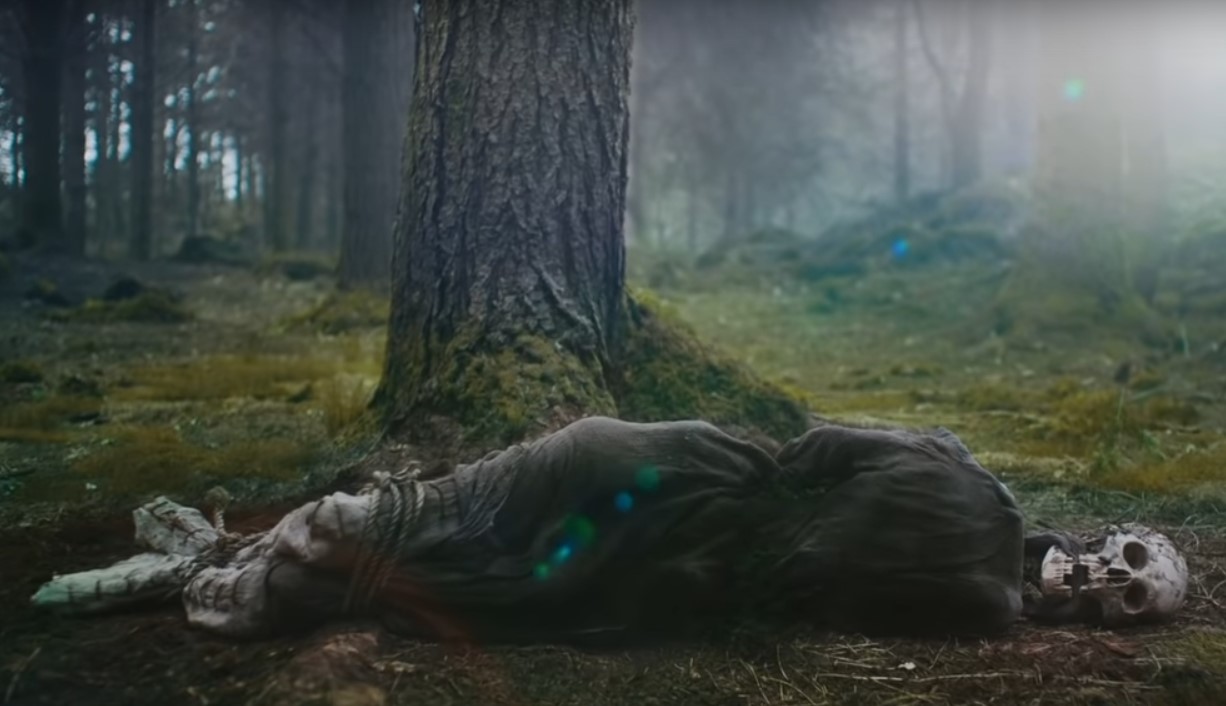
The sexual encounter between the Lady and Gawain heightens the drama in the narrative and is a prime example of why the poem works as a thriller film. It’s a forbidden, clandestine romance that is included specifically to show Gawain giving into his weaknesses and lusts, letting his desire for a woman ruin him. She is a femme fatale, seducing him by gifting him a book and telling him her philosophy on the color green and “painting his portrait,” which is actually a silver plate photograph. She makes herself absolutely desirable to him in order to test his strength and virtue, and Gawain gives in. It’s like a scene ripped from Dangerous Liaisons (1988) or Fatal Attraction (1987) because of its adulterous, forbidden nature.
And while The Green Knight works as a compelling thriller, some of these scene and thematic changes detract from the original text of the poem, which is decidedly more subtle in its emotional delivery and is predicated on Gawain’s naїvété. As a result, the film delivers on the thriller aspects, but at the same time, it loses the morality tale the Gawain poet sought to tell.
Misinformed Adaptation Or Visionary Retelling?
David Lowery’s film The Green Knight retells the medieval poem Sir Gawain and the Green Knight using the thriller genre, emphasizing the myths the story is associated with, heightening the magic, and intensifying the sexuality to show Gawain on his quest to find honor and become a knight. The film is beautifully shot and directed, with extreme attention to detail in even the largest wide shots of the fields and sky. Lowery makes a beautiful film and succeeds in creating a medieval thriller by prioritizing the more harrowing aspects of the poem, like Gawain’s journey to the Green Chapel and the affair he has with the Lady, in this suspense-filled tale.
But some of Lowery’s artistic liberties don’t hold up with the source material, which makes the term “adaptation” feel wrong to apply to the film. While the film does explore the themes of reciprocity, it’s not in the same way as the poem. The heart and detail in the poem are lost in attempting to make a thriller, like the massive hunt scenes and Gawain’s return to Camelot. The emphasis on sexuality and the added romantic plot don’t do much to add to the original story, but they do work for the goals of the film. The poem shifts from a medieval morality tale to a modern thriller. For those who admire the poem, the film is a disappointment in that regard — but that doesn’t mean that the beautiful scenes, wonderful acting, and haunting score aren’t achievements in and of themselves.
